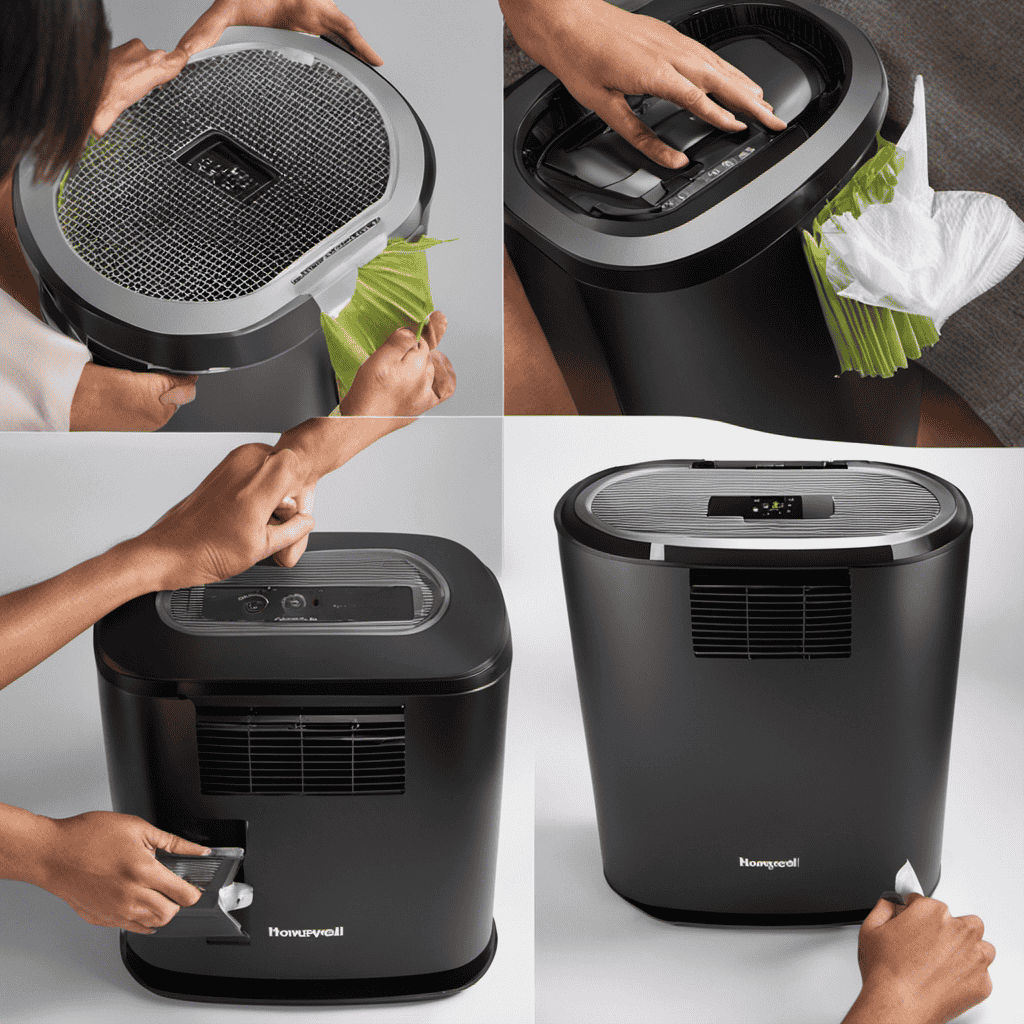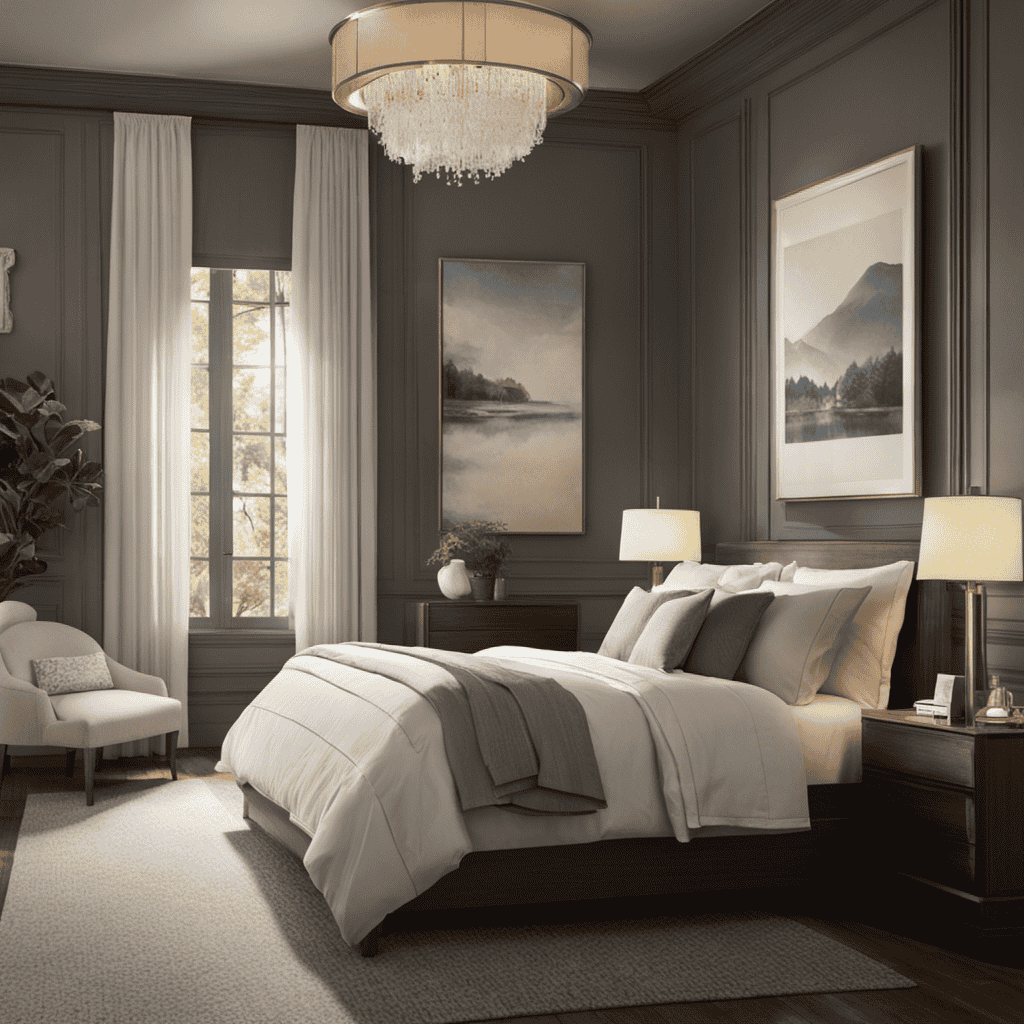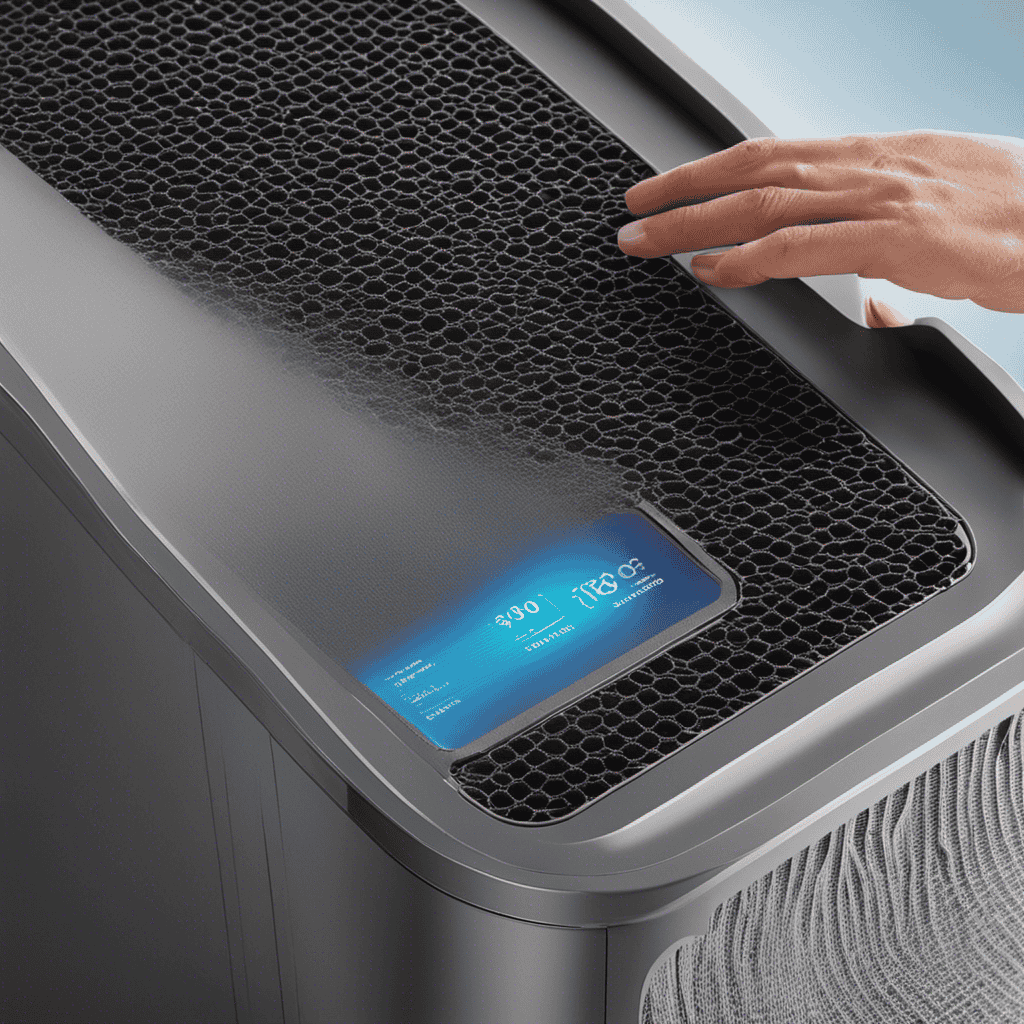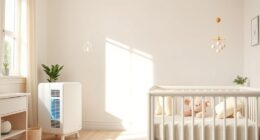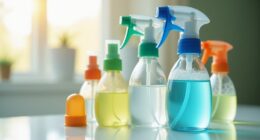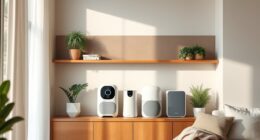As a homeowner, I have always been curious: what constitutes a good CADR rating? This question is frequently ignored, yet the response is essential for enhancing indoor air quality.
In this article, we’ll delve into the world of CADR ratings, exploring their importance, how they’re calculated, and the factors that can affect them.
By the end, you’ll have a clear understanding of what constitutes a good CADR rating and how to optimize it in your own home.
Key Takeaways
- CADR ratings measure the effectiveness of an air filter in removing pollutants from the air.
- Higher CADR ratings indicate faster and more efficient filtration.
- Factors such as room size, filter type, airflow speed, and indoor air quality affect CADR ratings.
- To improve CADR ratings, it is recommended to use high-quality filters, control moisture levels, and regularly clean and vacuum the home.
Understanding CADR Ratings
If you’re looking to understand CADR ratings, you’ll want to know what they actually represent. CADR stands for Clean Air Delivery Rate, which is a measure of how effectively an air filter can remove pollutants from the air. It is an important factor to consider when it comes to the importance of indoor air quality and the effectiveness of air filters.
Indoor air quality is crucial for our health and well-being. Poor air quality can lead to respiratory issues, allergies, and other health problems. Air filters play a significant role in improving indoor air quality by capturing and removing airborne particles such as dust, pollen, pet dander, and smoke. The CADR rating helps us understand how well an air filter can perform this task.
CADR ratings are determined through rigorous testing performed by independent laboratories. The measurement is based on three main pollutants: tobacco smoke, pollen, and dust. The higher the CADR rating, the more efficient the air filter is in removing these particles from the air. This means that a higher CADR rating indicates a faster and more effective filtration process.
When choosing an air filter, it is essential to consider the CADR rating to ensure that it is capable of effectively improving indoor air quality. A higher CADR rating means that the air filter can remove pollutants more quickly, leading to cleaner and healthier air in your home or office.
Importance of CADR Ratings
When it comes to air purification, understanding the efficiency of the device is crucial. It determines how well the purifier can remove pollutants from the air.
Choosing the right size of air purifier is also important as it ensures that the device can effectively clean the air in the space it is intended for.
Additionally, the health benefits of using an air purifier should not be overlooked, as it can help alleviate allergies, asthma symptoms, and improve overall indoor air quality.
Air Purification Efficiency
To improve air purification efficiency, you should consider purchasing an air purifier with a high CADR rating. The CADR rating, or Clean Air Delivery Rate, measures the effectiveness of an air purifier in removing pollutants from the air.
Here are four reasons why a high CADR rating is important for air purification efficiency:
-
Faster purification: A higher CADR rating means the air purifier can clean the air more quickly, reducing the time it takes to remove pollutants.
-
Larger coverage area: Air purifiers with high CADR ratings can cover larger spaces, ensuring that the purified air reaches every corner of the room.
-
Better removal of specific pollutants: Different air purifiers have different CADR ratings for different pollutants such as dust, pollen, and smoke. A high CADR rating ensures effective removal of specific pollutants that may be present in your environment.
-
Improved indoor air quality: By efficiently removing pollutants, an air purifier with a high CADR rating can significantly improve indoor air quality, reducing the impact of air pollution on your health.
Investing in an air purifier with a high CADR rating is a smart choice for improving air purification efficiency and creating a healthier living environment.
Choosing the Right Size
Choosing the right size of air purifier is crucial for ensuring optimal air purification efficiency and creating a healthier living environment.
When choosing the right model, it’s important to understand the benefits of selecting the appropriate size for your space. A common mistake is purchasing an air purifier that is too small for the room, which can lead to inadequate air purification and reduced effectiveness.
On the other hand, selecting a model that is too large for the space can result in unnecessary energy consumption and higher costs. By choosing the right size, you can maximize the air purification capabilities of the device and ensure that the air in your home is clean and fresh.
Take into consideration the square footage of the room and choose an air purifier that is designed to handle that size of space.
Health Benefits Explained
Did you know that using the right size air purifier can greatly improve your overall health? Here are four health benefits of using an air purifier:
-
Reduction of Allergens: Air purifiers can effectively remove allergens such as pollen, pet dander, and dust mites from the air, reducing the risk of allergic reactions and asthma attacks.
-
Elimination of Harmful Particles: Air purifiers can filter out harmful particles like smoke, bacteria, and viruses, improving indoor air quality and reducing the spread of illnesses.
-
Odor Removal: Air purifiers with activated carbon filters can help eliminate unpleasant odors, leaving your home smelling fresh and clean.
-
Better Sleep: By removing pollutants and allergens from the air, air purifiers can create a clean and healthy sleeping environment, promoting better sleep quality.
Using an air purifier with the right CADR (Clean Air Delivery Rate) can ensure that you’re getting the maximum health benefits. Now, let’s dive into how CADR ratings are calculated.
How CADR Ratings Are Calculated
When discussing CADR ratings, it’s important to understand the factors that can affect the accuracy of these calculations. Factors such as room size, airflow rate, and the type of pollutant being measured can all impact the final CADR rating.
Additionally, it’s crucial to examine the accuracy of CADR ratings to ensure that they are reliable and provide accurate information about a product’s effectiveness in removing pollutants from the air.
Factors Affecting CADR Calculations
To accurately calculate the CADR rating, you need to consider various factors. Here are four key factors that influence CADR measurements and have an impact on air quality and CADR ratings:
-
Particle Size: Different-sized particles have varying levels of effectiveness in air purifiers. CADR measurements are influenced by the ability of the purifier to filter out particles of different sizes.
-
Filter Efficiency: The efficiency of the air purifier’s filters plays a significant role in CADR ratings. Higher efficiency filters can remove more pollutants from the air, resulting in a higher CADR rating.
-
Room Size: The size of the room where the air purifier is used affects the CADR rating. Larger rooms require air purifiers with higher CADR ratings to effectively clean the air.
-
Pollution Levels: The initial air quality in the room also affects CADR ratings. Higher levels of pollutants require air purifiers with higher CADR ratings to achieve effective purification.
Considering these factors is crucial in accurately calculating CADR ratings and ensuring the air purifier meets your specific needs for cleaner and healthier air.
Accuracy of CADR Ratings
You should consider the accuracy of CADR ratings when choosing an air purifier to ensure it effectively cleans the air in your room.
CADR, or Clean Air Delivery Rate, is a measure of an air purifier’s ability to remove specific contaminants from the air.
The CADR rating is calculated by testing the air purifier in a controlled environment and measuring the amount of particles it can remove within a certain time frame.
However, it is important to note that the accuracy of CADR ratings can vary. Factors such as room size, temperature, and humidity can affect the performance of an air purifier and may result in different CADR ratings in real-world conditions.
Therefore, it is essential to consider the accuracy of the CADR rating and choose an air purifier that suits your specific needs and room conditions.
Factors That Affect CADR Ratings
Factors such as room size, filter type, and airflow speed can affect CADR ratings. When it comes to choosing an air purifier, understanding these factors is crucial as they directly impact the performance and effectiveness of the device in improving air quality.
Here are four key factors that can affect CADR ratings:
-
Room size: The size of the room plays a significant role in determining the CADR rating needed to effectively clean the air. Larger rooms require air purifiers with higher CADR ratings to ensure the air is adequately filtered.
-
Filter type: The type of filter used in an air purifier can greatly affect its CADR rating. High-quality filters, such as HEPA filters, are known for their ability to capture a wide range of airborne particles, resulting in higher CADR ratings.
-
Airflow speed: The speed at which the air purifier can circulate and filter the air also influences its CADR rating. Air purifiers with higher airflow speeds can clean the air more efficiently, leading to higher CADR ratings.
-
Indoor air quality: The initial air quality in a room can impact the CADR rating required to achieve desired air quality levels. If the air quality is severely contaminated, a higher CADR rating may be necessary to effectively purify the air.
Understanding these factors will help you choose an air purifier that best suits your needs and ensures optimal performance in improving air quality.
Different Types of CADR Ratings
Understanding the various types of CADR ratings can help you make an informed decision when selecting an air purifier. Different brands may have different types of CADR ratings, which determine the effectiveness of an air purifier in removing pollutants from the air. The CADR certification, issued by the Association of Home Appliance Manufacturers (AHAM), provides a standardized way to compare air purifiers across different brands.
There are three types of CADR ratings: smoke, pollen, and dust. The smoke CADR rating measures how well an air purifier can remove smoke particles from the air. The pollen CADR rating indicates the air purifier’s ability to remove pollen particles, which is important for individuals with allergies. Lastly, the dust CADR rating determines how effectively the air purifier can eliminate dust particles.
When comparing air purifiers, it is essential to consider all three CADR ratings. A high CADR rating in one category does not necessarily mean the air purifier is equally effective in all areas. It is recommended to choose an air purifier with CADR ratings that align with your specific needs and the pollutants you want to eliminate from the air.
Interpreting CADR Ratings
When interpreting CADR ratings, it’s important to keep in mind that higher numbers indicate a more efficient air purifier. CADR, or Clean Air Delivery Rate, is a measurement that tells you how effectively an air purifier can remove pollutants from the air.
To accurately interpret CADR ratings, consider the following factors:
-
Particle Type: CADR ratings are given for three types of particles: smoke, pollen, and dust. Each rating represents the air purifier’s ability to filter out a specific particle type. It’s important to choose an air purifier with CADR ratings that align with your specific needs.
-
Room Size: CADR ratings are typically given for a specific room size. It’s crucial to consider the square footage of the area you want to purify and choose an air purifier with CADR ratings suitable for that size. Using an air purifier with a lower CADR rating in a larger room may result in less efficient purification.
-
Number of Air Changes: The number of air changes per hour refers to how many times the air purifier can clean the entire room’s air in one hour. Higher CADR ratings mean the air purifier can achieve more air changes, resulting in cleaner air.
-
Brand Reliability: It’s important to consider the reliability and reputation of the brand when interpreting CADR ratings. Some brands may provide more accurate and trustworthy ratings, ensuring that the air purifier performs as expected.
Ideal CADR Ratings for Different Room Sizes
To determine the appropriate CADR ratings for different room sizes, it’s crucial to consider the square footage of the area you want to purify. For large spaces, such as living rooms or open-concept areas, it is recommended to have an air purifier with high CADR ratings. The ideal CADR rating for large spaces is around 350 or higher. This ensures that the air purifier can effectively filter and circulate the air in a larger area, providing cleaner and fresher air.
Additionally, it is important to consider the CADR rating requirements for asthma patients. Asthma patients often have sensitivities to airborne particles, such as dust, pollen, and pet dander. To effectively manage their symptoms, it is recommended to choose an air purifier with higher CADR ratings for specific allergens. Look for CADR ratings specifically for dust, pollen, and pet dander, and choose an air purifier with high ratings for these allergens to ensure effective purification.
In the next section, we will compare the CADR ratings of different air purifiers to help you make an informed decision when choosing the right air purifier for your needs.
Comparing CADR Ratings of Different Air Purifiers
Let’s compare the CADR ratings of different air purifiers to help you decide which one is best for your needs. When choosing the right model, it’s important to understand air filtration and how it can improve the quality of the air in your home or office. Here are four key points to consider:
-
CADR Ratings: CADR stands for Clean Air Delivery Rate and it measures the efficiency of an air purifier in removing specific pollutants from the air. The higher the CADR rating, the faster and more effectively the air purifier can clean the air.
-
Pollutant Types: Different air purifiers are designed to target specific pollutants such as dust, pollen, smoke, or pet dander. Understanding the main pollutants in your environment will help you choose an air purifier with the appropriate CADR ratings for those pollutants.
-
Room Size: Consider the size of the room where you plan to use the air purifier. The CADR rating should match the room size to ensure efficient air purification. Most air purifiers will specify the recommended room size for optimal performance.
-
Filter Replacement: Air purifiers require regular filter replacement to maintain their effectiveness. Check the cost and availability of replacement filters for each model you are considering, as well as the recommended filter replacement frequency.
Tips for Choosing an Air Purifier With a Good CADR Rating
When it comes to choosing an air purifier, understanding the importance of CADR rating is crucial. A higher CADR rating indicates that the air purifier can effectively remove pollutants from the air, making it more efficient at improving indoor air quality.
Several factors can affect the CADR rating, such as the size of the room, the type of pollutants present, and the speed settings of the air purifier.
Importance of CADR Rating
You should consider the CADR rating when choosing an air purifier. The CADR rating stands for Clean Air Delivery Rate and it measures the effectiveness of an air purifier in removing pollutants from the air. Here are four key reasons why the CADR rating is important:
-
Accurate Air Quality Measurements: The CADR rating provides a standardized measurement of an air purifier’s ability to filter out different types of pollutants such as dust, pollen, and smoke. This allows you to compare the performance of different air purifiers and make an informed decision.
-
Efficiency: A higher CADR rating indicates that the air purifier can clean the air faster and more effectively. This means that it can remove a higher volume of pollutants in a shorter amount of time, improving the overall air quality in your space.
-
Room Size: The CADR rating is also important for determining the appropriate air purifier size for your room. Different air purifiers have different CADR ratings for different room sizes, so you can select the right purifier that matches your room’s dimensions.
-
Health Benefits: By choosing an air purifier with a higher CADR rating, you can ensure that you are effectively removing harmful pollutants from the air. This can lead to improved indoor air quality, reducing the risk of respiratory issues and allergies.
Considering the CADR rating when choosing an air purifier is crucial for ensuring its effectiveness in improving the air quality in your space.
Factors Affecting CADR Rating
To understand the factors that affect CADR ratings, it’s important to consider the type of pollutants that an air purifier is designed to remove.
The CADR rating, or Clean Air Delivery Rate, is a measure of how efficiently an air purifier can clean the air in a specific size room. Factors influencing CADR performance include the type and size of the filter used, the strength of the fan, and the overall design of the purifier.
The impact of air quality on CADR ratings is significant, as the presence of high levels of pollutants can reduce the purifier’s effectiveness. Additionally, factors such as room size, ventilation, and the presence of other sources of pollution can also affect CADR ratings.
Therefore, it is crucial to consider these factors when choosing an air purifier to ensure optimal performance in improving indoor air quality.
Improving CADR Ratings in Your Home
Improving CADR ratings in your home can be achieved by implementing simple strategies. By taking steps to improve air quality and reduce allergens, you can optimize the performance of your air purifier and ensure a healthier living environment for yourself and your family.
Here are four effective strategies to improve CADR ratings in your home:
-
Regularly clean and vacuum your home: Dust, pollen, and other allergens can accumulate on surfaces and in carpets, contributing to poor air quality. Regular cleaning and vacuuming can help remove these particles and prevent them from circulating in the air.
-
Keep windows and doors closed: While fresh air is important, opening windows and doors can let in outdoor pollutants and allergens. To maintain better air quality inside your home, keep windows and doors closed, especially during peak pollen seasons.
-
Use high-quality air filters: Opt for high-efficiency particulate air (HEPA) filters that can capture smaller particles, including allergens, mold spores, and pet dander. Regularly replace the filters as recommended by the manufacturer to ensure optimal performance.
-
Control moisture levels: High humidity can promote the growth of mold and mildew, which can worsen allergies and respiratory conditions. Use a dehumidifier to control moisture levels and prevent the proliferation of these allergens.
Limitations of CADR Ratings
The limitations of CADR ratings can impact the effectiveness of air purifiers in improving indoor air quality. While CADR ratings provide a general guideline for the performance of air purifiers, they have some inherent limitations that can affect their accuracy. One limitation is that CADR ratings only measure the removal of three specific pollutants: smoke, pollen, and dust. This means that the effectiveness of an air purifier in removing other types of pollutants, such as pet dander or volatile organic compounds (VOCs), is not reflected in the CADR rating.
Additionally, CADR ratings are determined under specific laboratory conditions, which may not accurately reflect real-world scenarios. Factors such as room size, ceiling height, and air circulation can greatly influence the performance of an air purifier. Therefore, while an air purifier may have a high CADR rating, its actual effectiveness in a different environment may be lower.
To better understand the limitations of CADR ratings, let’s take a look at the following table:
| Limitation | Impact |
|---|---|
| Limited to specific pollutants | May not reflect effectiveness against other pollutants |
| Determined under laboratory conditions | Performance may vary in real-world scenarios |
Overall, while CADR ratings are a useful tool for comparing air purifiers, it is important to consider their limitations and take into account other factors when selecting an air purifier to ensure optimal indoor air quality improvement.
Common Misconceptions About CADR Ratings
After discussing the limitations of CADR ratings, it is important to address some common misconceptions that people may have about them. These misconceptions can often lead to misunderstanding the true benefits of high CADR ratings. Let me clarify a few of these misconceptions:
-
CADR ratings only measure the effectiveness of removing smoke particles from the air. This is not true. CADR ratings also take into account the removal of other common indoor air pollutants like dust, pollen, and pet dander.
-
Higher CADR ratings mean that the air purifier will be noisier. This is a misconception as well. While it is true that some high CADR rated models may produce more noise due to their powerful fans, there are many options available that are both highly effective and quiet.
-
CADR ratings are the only factor to consider when choosing an air purifier. While CADR ratings are important, they should not be the sole determining factor. Other factors such as filter type, room size, and energy efficiency should also be considered.
-
The CADR rating determines the overall effectiveness of an air purifier. While a high CADR rating is indicative of a more effective air purifier, it does not guarantee that the unit will completely eliminate all pollutants. It is important to understand that an air purifier should be used in conjunction with other measures to improve indoor air quality.
With these misconceptions clarified, it becomes clear that high CADR ratings offer numerous benefits. They indicate that an air purifier is efficient in removing a wide range of indoor air pollutants, leading to improved air quality. Additionally, air purifiers with high CADR ratings can help alleviate allergy and asthma symptoms by reducing the concentration of these triggers in the air.
Transitioning into the subsequent section, it is important to keep these benefits in mind when evaluating CADR ratings.
Final Thoughts on Evaluating CADR Ratings
When evaluating CADR ratings, it’s essential to consider other factors such as filter type, room size, and energy efficiency. While CADR ratings provide a useful measure of a purifier’s effectiveness, it’s important to approach them with a critical eye. One must evaluate the accuracy of the ratings and be aware of potential biases that may exist.
First and foremost, it’s crucial to ensure that the CADR ratings are reliable and accurate. This can be done by referring to trusted sources and conducting thorough research on the specific model you are interested in. Look for reputable organizations that have conducted independent testing and have a track record of providing accurate CADR ratings.
Additionally, it’s important to be aware of potential biases that may affect the CADR ratings. Some manufacturers may manipulate the test conditions to obtain higher ratings, making their products appear more effective than they actually are. It’s important to look for transparency in the testing methodology and consider the reputation and trustworthiness of the manufacturer.
Does a Higher Cadr Rating Mean a Better Air Purifier for Your Home?
When comparing air purifiers for your home, consider the CADR rating. A higher CADR rating means the air purifier can filter more particles efficiently. This directly impacts the benefits of air purifiers for home, ensuring cleaner air and improved indoor air quality for you and your family.
Frequently Asked Questions
Are CADR Ratings the Only Factor to Consider When Choosing an Air Purifier?
When choosing an air purifier, it’s important to consider multiple factors, not just CADR ratings. While CADR ratings give an indication of an air purifier’s effectiveness in removing certain pollutants, they don’t tell the whole story.
Other factors, such as the size of the room, the type of pollutants you want to remove, and the noise level of the purifier, should also be taken into account. Therefore, a good air purifier selection should consider all these factors to ensure optimal performance.
Can CADR Ratings Be Used to Compare Air Purifiers With Different Types of Filters?
When comparing air purifiers with different types of filters, it’s important to consider more than just CADR ratings.
While CADR ratings can give you an idea of an air purifier’s efficiency in removing pollutants, they don’t account for the specific types of particles the purifier is designed to target.
Different filters are designed to remove different types of pollutants, such as allergens, smoke, or odors.
Do CADR Ratings Indicate the Overall Effectiveness of an Air Purifier in Reducing Allergens and Pollutants?
CADR ratings indicate the overall effectiveness of an air purifier in reducing allergens and pollutants. However, it’s important to consider other factors such as price and energy efficiency when comparing different models.
A good CADR rating means that the air purifier is efficient at removing particles from the air. However, it’s essential to find a balance between a high CADR rating and the cost and energy consumption of the device.
Can CADR Ratings Be Influenced by the Placement of the Air Purifier in a Room?
When it comes to CADR ratings, one question that often pops up is whether the placement of an air purifier in a room can influence these ratings. Well, let me tell you, my friends, placement does matter!
The location of your air purifier can have a significant impact on its effectiveness in reducing allergens and pollutants. So, if you want to make the most out of your device, make sure to find the perfect spot for it in your room.
Are There Any Safety Concerns Associated With Air Purifiers With High CADR Ratings?
When it comes to air purifiers with high CADR ratings, there are some safety concerns to consider.
While these devices are efficient at removing airborne pollutants, they can also produce ozone emissions, which can be harmful to our health.
It’s important to choose air purifiers that have low ozone emissions or are ozone-free to minimize any potential risks.
Additionally, it’s always a good idea to follow the manufacturer’s instructions regarding usage and maintenance to ensure optimal safety and efficiency.
Conclusion
In conclusion, it is crucial to understand the importance of CADR ratings when evaluating air purifiers. These ratings provide a precise measure of an air purifier’s efficiency in removing specific pollutants from the air. By considering factors such as room size and the types of particles being targeted, you can determine the most suitable CADR rating for your needs.
Although CADR ratings have limitations, they serve as a valuable tool in enhancing indoor air quality. So, don’t overlook the significance of CADR ratings when selecting an air purifier – they can make a world of difference in your home.



